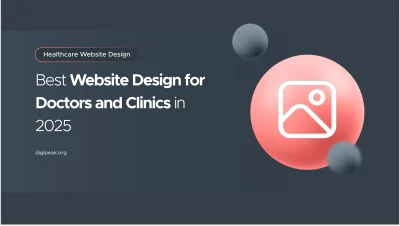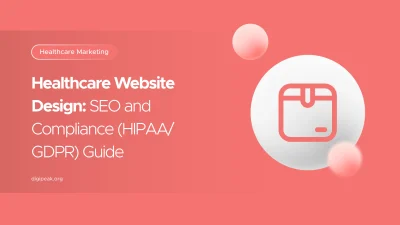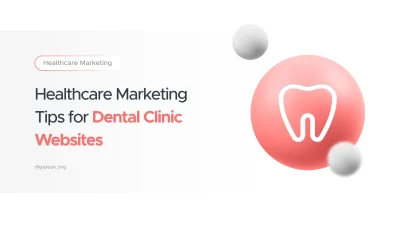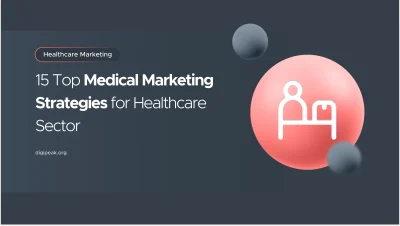
Best Website Design for Doctors and Clinics in 2025
As more patients turn to Google and smartphones for health information, a clinic’s website design …
18/09/2025 -
17 dk okuma
Stay up to date with Peakers
The healthcare sector is undergoing a profound digital transformation. For businesses operating in the B2B space—from medical device manufacturers and health IT startups to pharmaceutical companies and specialized service providers—this shift presents both immense opportunity and complex challenges. In this high-stakes, highly regulated environment, a one-size-fits-all marketing approach is not just inefficient; it’s a liability. This report, commissioned by Digipeak, serves as a definitive guide to B2B healthcare marketing, moving beyond basic principles to explore the nuanced strategies and viable business solutions that drive measurable, long-term success. We will deconstruct the unique challenges, analyze proven tactics, and forecast the future of this specialized domain.
Low Consultation / Appointment Rates?
Increase Bookings with a Free Funnel Review.
We’ll identify drop-off points from click to consultation and recommend fixes that actually convert. Request your free review.
This section deconstructs the fundamental differences that set B2B healthcare marketing apart, revealing why traditional B2B playbooks often fail. It establishes the core principles that must guide every strategic decision.
The B2B healthcare market is heavily regulated, with strict compliance required for laws like the Health Insurance Portability and Accountability Act (HIPAA) in the United States and the General Data Protection Regulation (GDPR) in Europe. These regulations set stringent rules regarding the use and disclosure of protected health information, which is central to most healthcare operations. For a B2B marketer, navigating these constraints is a daunting task that fundamentally reshapes every tactical decision, as it necessitates ensuring data protection and privacy in all communications and operations. Non-compliance is not a minor oversight; it can lead to severe legal issues and, critically, a profound loss of credibility in an industry where trust is paramount.
In this environment, a brand’s explicit and demonstrable adherence to compliance is not merely a legal constraint to be navigated; it is a strategic asset. Public perception of the healthcare industry is often viewed with skepticism and mistrust, making the establishment of a credible brand image vital. By consistently and transparently adhering to regulations and showcasing a proactive commitment to data security and ethical conduct, a company signals its reliability to a risk-averse audience. This approach transforms a potential liability into a powerful competitive advantage. It shifts the marketing narrative from “we sell X” to “we are a secure and trustworthy partner.” This foundational commitment to ethical standards and regulatory integrity serves as social proof that the brand prioritizes the security and well-being of its partners and their patients above all else. This is the bedrock upon which all other marketing efforts must be built.
Unlike B2C marketing, where speed and emotion often drive conversions, the B2B healthcare decision-making process is highly complex, demanding precision, clarity, and long-term relationship-building. The sales cycle is notoriously long, often lasting between 6 to 18 months. This extended timeline is a direct result of the multitude of stakeholders involved; a purchasing decision typically requires input from four to seven internal stakeholders. The sheer number of decision-makers and their diverse, often competing, motivations create a multi-layered challenge that cannot be solved with a single marketing message.
The viability of a marketing solution hinges on a brand’s ability to create a cohesive, multi-touch strategy that speaks a different “language” to each stakeholder, ultimately building consensus across the entire buying committee. Each constituent of the committee has a unique set of priorities. C-suite executives focus on big-picture goals like measurable ROI, scalability, and operational improvements. Clinical leaders and physicians, on the other hand, prioritize workflow efficiency, patient outcomes, and solutions that enhance their practice. Procurement teams are concerned with pricing models and compliance with purchasing policies. Finally, compliance and legal officers scrutinize solutions based on their privacy features and legal safeguards. A marketing campaign that only targets physicians with messages about efficiency will fail to address the concerns of the procurement or C-suite teams, making a sale unlikely to close. The long sales cycle is not just a matter of time; it is a symptom of the need for alignment among these disparate, often competing, priorities. A viable marketing strategy must proactively address the concerns of the entire “buying committee” simultaneously, which is why a precision-focused approach is so critical.
In an industry marked by skepticism, establishing trust and credibility is paramount for B2B healthcare marketers. Healthcare decisions significantly impact patient care, making reliability and authority the key drivers of any sale. For this reason, a buyer’s reliance on evidence-based and data-driven information is not just a preference; it is a necessity. Every stakeholder requires clear, substantiated information before considering a solution. To meet this need, successful B2B marketers must use a variety of content formats to demonstrate their expertise. Testimonials and case studies from respected professionals and institutions serve as powerful social proof, showcasing real-world effectiveness with measurable results. Whitepapers provide in-depth analyses and research findings that establish a company as an authoritative source. By consistently providing valuable, well-researched content, a brand can position itself as a trusted authority, building the foundational trust necessary to secure long-term partnerships.
This section details the core pillars of any successful B2B healthcare marketing strategy, emphasizing how they must be tailored to the industry’s unique demands.
In the modern B2B healthcare landscape, a professional, user-friendly, and mobile-optimized website is a vital “digital front door”. It must provide comprehensive information about services and feature clear calls-to-action to guide potential clients. However, a website’s role in this industry extends far beyond that of a simple brochure. It is the central hub for the entire complex, multi-touch buyer’s journey, and its architecture must be designed to support the specific needs of multiple, distinct personas. The reality of B2B healthcare is that buyers are doing an estimated 70% of their research independently before they ever contact a sales representative. For a business to be a viable solution, its website must serve as a self-guided resource that anticipates the informational needs of each stakeholder.
For example, the website must provide easy access to ROI data for C-suite executives, evidence-based research for clinical leaders, and compliance documentation for legal officers. A fragmented, inflexible tech stack can severely hinder this process. The case of Presbyterian Healthcare Services and its partnership with Webstacks perfectly illustrates this point. Their challenge was not just an outdated design but an accumulation of technical debt and a fragmented system of six separate websites that made content management and publishing difficult. This monolithic tech stack couldn’t support the multi-audience journeys and compliance requirements of a modern healthcare organization.
The solution, migrating to a headless CMS and building a modular design system, was a foundational business decision that enabled a more effective marketing strategy. It created a single source of truth for their digital presence, streamlining operations and empowering marketing teams to adapt quickly to shifting priorities, thereby ensuring their website could evolve with the organization long into the future.
Content is a vital component of any B2B healthcare marketing strategy, as it bolsters SEO, positions a business as an industry leader, and helps nurture prospects through the sales funnel. In this industry, where trust precedes a high-stakes sale, content marketing’s viability is not in volume alone, but in its strategic alignment with the buyer’s journey and the specific needs of each persona. Healthcare buyers are analytical, well-educated, and evidence-based, requiring clear and data-driven information before considering a solution. This is why a simple blog post is often not enough to convert a lead.
The content strategy must escalate in detail and authority, creating a logical and persuasive “content trail” that mirrors the buyer’s internal deliberation process. This content trail should include:
This strategic escalation from broad awareness-stage content to detailed, ready-to-buy documentation is what separates effective content marketing from content that simply fills a page.
Given the complexity of the healthcare buyer’s journey, Account-Based Marketing (ABM) is a highly effective, personalized strategy that directly addresses the multi-stakeholder challenge. Instead of casting a wide net, ABM focuses marketing resources on a specific, high-value account, generating more qualified leads and accelerating sales cycles by building direct connections with business leaders. It has been reported that ABM has a higher chance of closing deals and outperforms other marketing methods in terms of ROI.
ABM’s viability in healthcare lies in its ability to orchestrate a coordinated, multi-front engagement strategy that addresses the unique objections and motivations of every key player on the buying committee. This requires a hyper-personalized approach that targets accounts by job title, organization type, and geographic location. For example, a campaign targeting a specific hospital can deliver a message about “data security” to the CIO, “workflow efficiency” to the clinical leader, and “cost-effectiveness” to the procurement head. Similarly, messaging can be customized for hospitals, which prioritize scalability and regulatory compliance, versus private practices, which focus on affordability and quick ROI. This approach is the logical framework for a market where trust and consensus are paramount, as it bypasses the inefficiency of broad campaigns and focuses on the precise points of influence to cut through long sales cycles.
This section details the digital and in-person channels that are most effective for B2B healthcare marketers, providing tactical advice for leveraging each one.
Search Engine Optimization (SEO) and Search Engine Marketing (SEM) are crucial for increasing a company’s online visibility and organic traffic, ensuring potential clients can find the business easily online. In a content-driven industry, SEO is not just a technical task; it is an exercise in anticipating and answering the specific, evidence-based questions of a highly educated, analytical audience. An effective strategy starts with a thorough digital audit, followed by keyword research and a comprehensive competitor analysis to build a solid foundation. The focus should be on long-tail, industry-specific keywords that address a prospect’s pain points. An “FAQ hub” that directly answers questions like, “How do I prepare for a hip replacement?” or a blog post that clarifies a new regulation will not only boost search rankings but also build authority and trust by demonstrating genuine expertise.
While SEO builds long-term organic presence, SEM provides a powerful, immediate boost to visibility through paid search campaigns. The key to success with both is to be present where decision-makers are already looking. By aligning your SEO and SEM efforts with the specific, technical queries of your target audience, you can ensure your brand is the first stop for critical information, significantly improving lead quality and conversion rates.
Social media, particularly LinkedIn, is an invaluable tool for B2B healthcare companies to connect with industry peers and decision-makers. Maintaining an active and engaging presence is essential, as an inactive profile can be perceived as outdated or negative by potential clients. The professional network can be leveraged for sharing updates, engaging in discussions, and promoting content to build a professional network and foster relationships.
Take Advantage of Digipeak’s 5+ Years of Expertise
This channel is amplified by video marketing, a versatile and dynamic tool that is essential for B2B healthcare. Videos can enhance engagement and educate audiences by simplifying complex offerings and building trust by showing the team members a prospect might interact with. The combination of LinkedIn and video marketing addresses the dual nature of B2B healthcare sales: the need for evidence-based logic and the human element of trust. A B2B healthcare buyer is analytical and seeks a long-term partner they can trust. By sharing a video on LinkedIn that simplifies a complex product, a company can simultaneously appeal to the buyer’s rational need for information and their emotional need for a trustworthy relationship, thereby creating a crucial “balance of evidence-based and relationship marketing”.
A multi-channel approach is not just a trend but a necessity because B2B healthcare decision-makers are on various digital and traditional platforms. The buyer’s journey is long, and it takes an average of eight touchpoints to generate a conversion. The most effective strategies expertly weave together digital, traditional, and experiential channels to deliver a unified message and a frictionless buyer journey. Key channels to prioritize include:
LinkedIn and Medscape: These are platforms where professionals are most active, making them ideal for sponsored posts, InMail campaigns, and sponsored articles.
Email Marketing: It remains a highly effective channel for nurturing leads and maintaining contact during the long sales cycle, especially when content is personalized to the recipient’s interests.
Industry Podcasts and Association Websites: Niche podcasts offer sponsorship or guest appearance opportunities to deliver high-value content to busy executives, while association websites provide a channel for sponsored content and webinars on trusted sites.
Industry Events: Participating in conferences and trade shows provides opportunities for direct engagement, showcasing services, and generating leads.
The success of an omnichannel strategy is predicated on the ability to tie these channels together with a robust Customer Relationship Management (CRM) system. A CRM system tracks all interactions, allowing for tailored marketing efforts that enhance personalization and ensure no leads slip away. This cohesive approach ensures each touchpoint reinforces brand trust and facilitates informed decision-making.
This section looks forward, exploring the emerging trends and technologies that will define the future of the industry, particularly the transformative role of AI.
AI is not merely a buzzword; it is a technology poised to revolutionize B2B healthcare marketing by enabling hyper-personalization at scale, enhancing predictive analytics, and automating routine tasks. AI-driven predictive analytics use historical data and machine learning to anticipate future behaviors, helping marketers identify individuals who are most likely to convert and when. This empowers businesses to launch precision-targeted campaigns, such as promoting a new service to a high-risk population. AI also streamlines marketing operations by automating tasks like lead scoring, content repurposing, and campaign deployment, freeing up teams to focus on higher-level strategic work.
However, the true value of AI lies in its ability to empower human marketers to focus on the high-value, relationship-building tasks that are critical in this trust-based industry. The biggest challenge isn’t the technology itself, but maintaining ethical and compliant data practices. Any B2B healthcare marketing that analyzes user data must comply with strict regulations like HIPAA and GDPR, necessitating a clear policy on data governance. While AI can produce surface-level content or analyze engagement data to predict who is most likely to convert, a human marketer is still needed to craft the compelling, personalized message that closes the deal. The future is a symbiotic relationship between AI-driven precision and human-led empathy, where AI handles the monotonous tasks, allowing humans to focus on creative strategy and patient-centric innovations.
In B2B healthcare, the primary goal of any marketing strategy is to provide a tangible return on investment (ROI). However, in a market with long sales cycles and high-value clients, the focus must shift from short-term lead volume to the long-term quality and lifetime value of each customer. While the basic ROI formula is straightforward—(Revenue Generated – Marketing Investment) / Marketing Investment x 100, its application in healthcare is complex. The viability of a long-term strategy cannot be judged by simple, short-term metrics. For example, a campaign might generate a lot of leads but not a lot of revenue. The true measure of success lies in the ability to track and demonstrate ROI through metrics that account for the long-term nature of partnerships.
Key metrics that a business must track include:
Online marketing is a viable business solution in this context precisely because it gives marketers more data than any other channel, allowing them to make informed decisions about budget allocation and strategy. The ability to accurately measure the impact of marketing efforts on both revenue and operational efficiency is what transforms a campaign from a simple expense into a strategic, viable business investment.
To provide concrete, actionable examples of the principles discussed, we can analyze several successful campaigns that have served as blueprints for success in the B2B healthcare space. The following table synthesizes key case studies, providing a quick-reference guide that connects a brand’s strategy to its channels and outcomes.
| Campaign/Brand | Core Strategy | Key Channel(s) & Tactic(s) | Demonstrated Impact |
| Cleveland Clinic | Human-centered storytelling and content authority | Blogs, Educational video marketing | Positioned as a trusted authority, built emotional connection |
| Mayo Clinic | Community-building and humanization | Multi-channel blog, Social media engagement | Fostered a sense of community, made a prestigious brand approachable |
| iRhythm | Specialist audience engagement | Paid media, SEO, medical copywriting, UX | Accelerated market adoption of innovative medical device |
| Presbyterian Healthcare Services | Foundational tech stack modernization | Headless CMS, Modular design system | Streamlined website operations, enabled multi-audience journeys |
| AI Performance | Leveraging AI for compliance and optimization | AI-led paid media campaigns | Cut CPA by 37%, grew leads by 212% in regulated markets |
Cleveland Clinic, for example, transformed its perception by leveraging its “Health Essentials” blog to become a trusted authority and humanized its clinical care with a powerful video titled “Empathy: The Human Connection to Patient Care”. This approach demonstrated that a brand could connect with its audience on an emotional level while providing credible information. Similarly, the Mayo Clinic’s “Sharing Mayo Clinic Blog” used patient and staff stories to build community and make a prestigious institution feel approachable and relatable.
In a different vein, iRhythm’s case study highlights a launch-focused strategy that used a combination of paid media, SEO, and specialized medical copywriting to accelerate the market adoption of a new cardiac monitoring tool. This approach demonstrates the power of targeting a specialist audience with precision and authority. The AI Performance case study further illustrates the strategic viability of modern technology, showing how AI-led compliance can significantly improve paid media performance by slashing Google Ads disapprovals and reducing cost-per-acquisition. These examples are not just isolated success stories; they represent distinct strategic blueprints that prove how a nuanced understanding of the market, combined with a precision-focused, multi-channel strategy, can lead to measurable and transformative business outcomes.
In a market where decisions are made by committee, governed by regulation, and measured by impact on human lives, B2B healthcare marketing is a discipline of precision, trust, and strategic patience. The viable business solutions are not found in generic marketing tactics, but in a holistic approach that prioritizes ethical compliance, leverages data-driven insights to hyper-personalize outreach, and builds authority through consistent, evidence-based communication.
By embracing these principles and the future-forward trends of AI and omnichannel engagement, brands can navigate the complexity, build lasting relationships, and ultimately, deliver measurable value in a high-stakes industry. Digipeak stands ready to be your partner in this transformative journey.
Get an Offer


Join Us So You Don't
Miss Out on Digital Marketing News!
Join the Digipeak Newsletter.
Related Posts

As more patients turn to Google and smartphones for health information, a clinic’s website design …

Healthcare websites serve as a digital marketing front door for practices and hospitals, so they …

today’s competitive dental industry, a polished, optimized website is the cornerstone of attracting new patients. …

In today’s healthcare landscape, effective medical marketing, aka healthcare marketing, is crucial for clinics and …